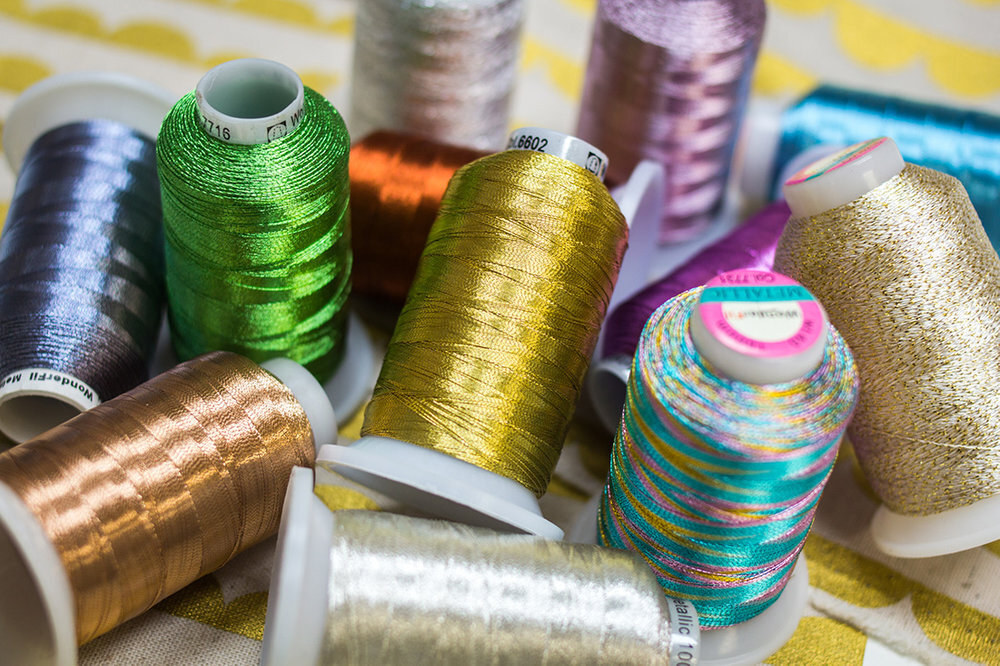Introducing Spotlite™ 40wt Rayon Core Metallic Thread
Maura Kang
Metallic threads are a gorgeous choice for any decorative stitching, machine embroidery, or decorative quilting. They shine in a way no other thread can. But many people struggle to use metallic threads because they can be a little more fickle to sew with than others. Let’s take a closer look at WonderFil’s 40wt metallic thread called Spotlite and what makes this special thread stand out.
Metallic threads are designed with a thin metallic foil wrapped around a core made of another material. Many thread manufacturers will use polyester for the core because polyester is a strong, durable material. However, polyester also tends to carry a stretch to it. As the thread passes through the thread path in the machine and around all those bends, it can stretch around those bends, causing thread breaks. Stronger doesn’t always equal better in this case.
This is why WonderFil takes a different approach and uses rayon for the metallic thread’s core. Rayon carries zero stretch to it, meaning it won’t stretch around the bends in a machine’s thread path. This leads to fewer thread breaks and shredding, as well as a higher stitch quality.
We always recommend choosing a quality metallic thread as not all metallic threads are made equally. The quality of the thread you use will directly impact how easy it is to sew with, which is especially noticeable when using a metallic thread.
So, what can you use metallic threads for? The possibilities are truly endless. Because of metallic’s beautiful sheen, you can achieve a look and texture not possible with any other kind of thread. Even a single stitch of metallic can add a pop of sparkle to your quilts. Should you choose to quilt with metallic thread, we recommend using it only for art quilts, wall hung quilts, or small areas of decorative stitching on bed quilts, as metallic thread doesn’t have the same strength as regular quilting threads.
Quilting with Spotlite™ 40wt rayon core metallic.
Denser stitching such as thread painting will really show off the iridescent beauty of Spotlite thread. Artist Teri Cherne stitched layers of Spotlite to create this stunning thread painted piece. You can also use it in the embroidery machine for a beautiful metallic look to your embroidery designs. This thread is an exceptional choice for freestanding lace patterns, and you can easily and quickly make freestanding lace ornaments for the holidays.
For best results, always pair Spotlite thread with a super fine bobbin thread like DecoBob 80wt cottonized polyester. This fine thread plays nice with any top thread, which makes a big difference in the stitch quality of a metallic thread. It will also further reduce thread breaks and shredding, and prevent tension changes.
You should also ensure you’re using the right needle for this thread. We recommend a 90/14 or 100/16 topstitch needle, or a 90/14 metallic needle. Topstitch needles have a larger eye, giving the metallic thread more space to move around and preventing the thread from shredding. Metallic needles are designed to shield the thread as it passes through the fabric, which also prevents shredding. Both needles are a good choice when using this thread. You can also use Spotlite on the longarm machine with a size 16 needle.
While metallic threads aren’t usually recommended for hand sewing, you can get away with it if you cut shorter strands. Choose a sharps needle with an eye large enough to fit the thread and only cut strands no longer than 18 inches long, or you may end up with tangling issues.
You can choose from a range of 40 different colours with Spotlite. Or pick up a Spotlite tube which includes 4 coordinated colours, as well as a free sheet of Wonder Guard.
If you haven’t used a Wonder Guard before, this handy little thread guard is a must for metallic threads. Simply wrap it around the spool, snugly but not too tightly, and you can actually sew with it on.
If you’ve used metallic threads before, you’ll notice they tend to have a curl to them, or a memory. This is the thread holding the shape of the spool it was wrapped around. A Wonder Guard will help pull those curls off the thread as the thread draws off the spool, preventing those curls from entering the machine and messing up your tension. They’re also perfect for storing the thread when you’re not using it!
For our guide on how to sew with metallic threads easily, don’t forget to check out our video, “How to Sew With Metallic Threads (Without the Headache)”.
Inspired to sew with Spotlite? Head on over to shopwonderfil.com for a list of stores and retailers you can purchase from. You can also sign up to receive weekly sewing tips, free patterns, and tutorials in our newsletter. Register by clicking here! You can unsubscribe at any time by clicking the unsubscribe button on the footer of every email you receive.


















